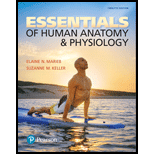
More than one choice may apply.
Which of the following are accessory sex structures in the male?
a. Gonads
b. Gametes
c. Broad shoulders
d. Semical vesicles
Introduction:
Male reproductive system is composed of two types of organs. One is the primary sex organs that are involved in the production of sex hormones (testosterone) and the male gamete. The other one is accessory male organs that produce and nourish the male gamete. Accessory male organs are internal structures present in the males, which includes, seminal vesicles, vas deferens, and prostate gland.
Answer to Problem 1MC
Correct answer:
Seminal vesicles are the accessory sex structures in the male.
Explanation of Solution
Explanation for the correct answer:
Option (d) is given that seminal vesicles are the male accessory sex organs. Seminal vesicles are hollow glands that are the accessory glands in the males. They secrete seminal fluid, rich in components such as prostaglandins, fructose, and vitamin C. Seminal fluid nourishes sperms. Hence, option (d) is correct.
Explanation for incorrect answers:
Option (a) is given that gonads are the male accessory sex organs. However, gonads (testes in case of males) are known as the primary sex organs. They produce sex hormones and gametes. So, it is an incorrect option.
Option (b) is given that gametes are the male accessory sex organs. Gametes (sperms in case of male) are produced from the primary sex organs and are not accessory sex organs. So, it is an incorrect option.
Option (c) is given that broad shoulders are the male accessory sex organs. Broad shoulders are the secondary sexual characteristics in the male induced by the release of hormones. They are not male accessory organs. So, it is an incorrect option.
Hence, options (a), (b), and (c) are incorrect.
Seminal vesicles are the male accessory organs, which produce seminal fluid and nourishes the sperm.
Want to see more full solutions like this?
Chapter 16 Solutions
Essentials of Human Anatomy & Physiology (12th Edition)
- Sperm are produced in the _______. a. scrotum b. seminal vesicles c. seminiferous tubules d. prostate glandarrow_forwardWhich of the following is a cause of cryptorchidism? Select one: A. Testicular cancer B. Infertility C. Prostatitis D. Short spermatic cord E. High serum testosterone O O O O Oarrow_forwardMatch each item in column A with the most closely related item in column B. Place letters for answers in the spaces provided.arrow_forward
- The reason why the testes are suspended in the scrotum is to :A.Create extra space for the sex organs B.Reduce the chance of infection from the enteric bacteria C.Place sperm storage sites nearer the penis D.Protect sperm from the immune system E.Provide cooler temperaturearrow_forwardE B A В Identify the structure that secretes the hormone involved in the development of the secondary male sex characteristics and contributes to spermatogenesis. Select one: a. D, which is the Sertoli cell b. A, which is the spermatocyte O c. C, which is the sperm cell O d. B, which is the interstitial cellarrow_forwardProvides support and nourishment for the spermatids A. Labia majora B. Clitoris C. Sertoli D. Vulva E. Greater vestibular glandsarrow_forward
- Which of the following statement correctly describe the role of androgen in the male reproductive system? Select one: A. LH stimulates the Sertoli cell to produce inhibin and to start spermatogenesis. B. Increased levels of inhibin released by the interstitial cells result in lower levels of FSH and testosterone. C. Increased levels of testosterone feedbacks negatively to the anterior pituitary and hypothalamus. D. GnRH is released by the anterior pituitary and stimulates the release of FSH and LH.arrow_forwardDetermine the pathway of sperm. A. Seminal vesicles → vas deferens → testes → prostate gland →bulbourethral glands → urethra B. Vas deferens → testes → seminal vesicles → prostate gland →bulbourethral glands → urethra C. Testes → seminal vesicles → vas deferens → prostate gland -bulbourethral glands → urethra D. Testes → vas deferens → seminal vesicles → prostate gland -bulbourethral glands → urethra Identify the variation of chromosome structure that is excised and rotated 180 degree within the same chromosome. A. Duplication B. Inversion C. Nondisjunction D. Non-rotationarrow_forwardWhich of the following is not a mechanism on how contraceptive pills work to prevent pregnancy? A. thinning the endometrium to prevent implantation B. inhibition of follicular development and suppression of ovulation C. progesterone inhibits the sperm from penetrating through the cervix and female upper tract by making the cervical mucus unfriendly D. stimulates the production of high testosterone levelsarrow_forward
- Match the structure with its functionarrow_forwardWhich of the following statements about the male reproductive system is false? a. The vas deferens carries sperm from the testes to the penis. b. Sperm mature in seminiferous tubules in the testes. c. Both the prostate and the bulbourethral glands produce components of the semen. d. The prostate gland is located in the testes.arrow_forwardOne of the roles of follicle-stimulating hormones(FSH) in the female reproductive system is Select one: A. To trigger the thickening of the endometrium in the luteal stage B. To promote menstruation during the follicular stage C. To promote menstruation during the luteal stage D. To trigger the thickening of the endometrium in the follicular stagearrow_forward
- Essentials of Pharmacology for Health ProfessionsNursingISBN:9781305441620Author:WOODROWPublisher:Cengage
 Concepts of BiologyBiologyISBN:9781938168116Author:Samantha Fowler, Rebecca Roush, James WisePublisher:OpenStax College
Concepts of BiologyBiologyISBN:9781938168116Author:Samantha Fowler, Rebecca Roush, James WisePublisher:OpenStax College




